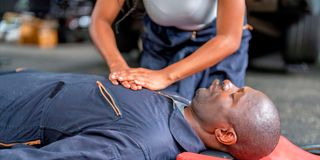Explainer: When and how to do Cardiopulmonary Resuscitation

In first aid, Cardiopulmonary Resuscitation (CPR) is the most life-saving skill.
What you need to know:
- You start by pressing the centre of the chest.
- Interlock your hands to help give the right chest compressions.
In the blink of an eye, an emergency can unfold. Let us set a scenario. You are walking on the streets, and someone collapses in front of you. As a good Samaritan, you check on them and realise that they are struggling to breathe. Or, someone has choked at home.
Medical experts say that your reaction could mean the difference between life and death.
In that moment when every second counts, there's a life-saving skill you can perform on the casualty that can help keep them alive until more advanced medical care can be provided.
Babu Sitima, the training manager at Safetynet Consultancy Limited, a firm that offers training on first aid and other safety courses, calls it “the kiss of life.”
“It is called Cardiopulmonary Resuscitation (CPR), and in first aid, it is the most life-saving skill. It is a science that helps the body do its job. It is a skill that saves lives. It is the most important skill in any rescue operation,” he says.
This, he explains, is when you meet someone who doesn’t have signs of life.
But, how do you tell that someone needs CPR? The first thing that you should as Mr Sitima explains, is to check whether the casualty is responsive or not.
“Imagine you have a sleeping child who is late for school. In many households, there's an unspoken routine: first, you call their name. When there's no response, someone moves closer and taps them. If that still doesn’t work, they’ll try to shake the person, becoming a bit more forceful in their efforts. The same setting, put it in an incident,” he offers.
However, with the incident, there is prior information. “Like what is happening in the country. Someone has been clobbered during the protests or attacked in a different scenario. If you try to wake them up and they don’t, that’s already an indication of an emergency. So, you investigate further and realise that this person is not breathing, then this calls for CPR, even as you plan for advanced medical attention.
How do you check if someone’s heart is beating or not?
We usually check the neck. You take two fingers and place them on the neck. You will feel what we call the carotid pulse. It is very strong and apparent.
Advice: To protect yourself from infections, use a glove or any clean polythene material that is non-porous at your disposal.
“CPR is a sequence. It is just not done randomly. And how you do it on an adult is different from a child.
CPR for an adult (chest compressions):
* You start by pressing the centre of the chest. To get to the centre, you trail your hands from the armpits, and where they fall at the centre, that is where you press.
* Interlock your hands to help give the right chest compressions.
* The recommended protocol is that you push the chest 30 times.
* Press hard and fast. And this fastness, he offers, is relative to the formula of a normal person’s heartbeat.
* You are trying to press oxygenated blood to the brain until it receives oxygen. What you are doing is buying time to keep the brain alive.
According to Mr Sitima, the other skill is blowing into the mouth.
“You are blowing into the mouth to introduce oxygen, which is beneficial to the entire process. You are facilitating a process that the body is not able to. If you are doing rescue breaths, you have to protect yourself and the casualty. In this case, you can continue pressing on the chest. If it's someone you are comfortable doing this on, you blow until the chest rises, then proceed to do chest compressions 30 times and continue the sequence until the ambulance arrives, ” he offers.
In his telling, if you do it too fast, you will not give the chest time to recoil and if you press anywhere else but the chest, you are not helping the casualty.
CPR for a child:
* Start by laying them on a heightened surface.
* Take two fingers and place them on the nipples of the baby, and press as you hold their heads. This is because a baby under three months may not have neck control.
* For babies, we do 15 chest compressions.
* Then, carefully blow twice into their mouth and nose, then repeat the chest compression 15 times.


